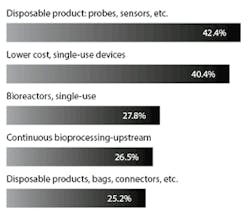The single most important biomanufacturing trend in recent years is manufacturing efficiency. Nearly 20 percent of the industry believes that it needs to increase efforts to produce more, do so more quickly, and with fewer resources. This conclusion, drawn from BioPlan Associates’ 14th Annual Report and Survey of Biopharmaceutical Manufacturing Capacity and Production, shows the bioprocessing industry continues to express concerns about its ability to optimize operations.
Exhibit 1: Selected Upstream New Product Development Areas of Interest (Top areas suppliers should focus their development efforts on)
How the industry invests in improvements today will define the strategic direction bioprocessing takes for years to come. In our study, we identified the most important areas in which biomanufacturers expect their suppliers to be focusing their new product development efforts. The top five of 13 “upstream” bioprocessing areas of interest are shown in Exhibit 1. These include single-use devices and continuous bioprocessing innovations. Many of the remaining upstream bioprocessing areas also involved single-use devices as well.Demands for “downstream” innovations mirror the upstream general areas, and include single-use purification (noted by nearly 36 percent), protein-A alternatives and multiple continuous bioprocessing options. In addition, other, general areas demanded for bioprocessing innovation include ‘“automation, instrumentation” (indicated by nearly 22 percent) and “analytical assays.”
This granularity focused on interest in future innovation and provides a clear perspective of the factors driving needs for overall productivity and efficiency. These are the factors most likely to provide the forward momentum the industry needs to improve efficiency and meet its productivity goals.
The major factors that will continue to advance biopharmaceutical manufacturing efficiency include continuous bioprocessing and single-use systems implementation and integration. Implementing such manufacturing changes tend to require long-term strategic decisions. In a regulated environment, such changes are not done quickly, and introduction of new innovations is not straightforward in this industry due to regulatory issues and long product development time. Regardless, biomanufacturers are willing to pay for innovation to remain competitive, resulting in a continued demand for better ways to cut down time to market and streamlining the overall bioprocessing.
CONTINUOUS BIOPROCESSING
The migration toward continuous bioprocessing has been a natural progression following other major manufacturing industries like chemical and steel. Traditionally, the industry has operated using batch processing modalities where operations are segregated spatially and temporally. Operating in this way for decades, the bioprocessing industry has relied on capital and operational expenditure to allow for growth and improvements while not significantly changing the process methodology.
In our report, 26.5 percent of respondents stated that the top new product development area of interest for biomanufacturers and CMOs is continuous bioprocessing-upstream, but 33.8 percent noted they need continuous downstream innovation. Continuous bioprocessing remains a key area suppliers are expected to focus their developmental efforts.
Continuous processing is also a logical next step for biopharmaceutical manufacturing. It reduces facility downtime, overall costs, equipment size, raw material need and the overall timeline. While continuous processing may not always make sense very early in a product’s development, it can become more attractive once the long-term success of the product and demand for further manufacturing are known.
Implementation of perfusion technologies, which has been limited due to the overall complexity, has begun to pave the way for continuous processing in upstream manufacturing. The early adopters of continuous processing tend to be those who have experience with perfusion technology. These manufacturers have worked through some of the complexities. Recently, continuous processing is becoming more attractive due to the reduction in processing costs and the reduced scale needed. This is particularly attractive where smaller bioreactors and smaller downstream equipment are all that is needed.
One of the key challenges of continuous processing is the assurance that material removed from the bioreactor at different times is of consistent quality. Companies with experience in perfusion technology have demonstrated the steady-state capabilities of a perfusion process and the potential of a more homogenous product. This will be achieved through more real time process monitoring like biomass sensors, in-line metabolite analyzers and pCO2 sensors. Further gains in efficiencies will be seen from increased real-time analytical automation.
Looking forward, how the biomanufacturing industry handles downstream continuous processing is where the focus will lie. Perfusion processes have been well established for continuous upstream manufacturing, so the real leap for the industry will happen in downstream processing. While there are several hurdles to jump through, one example is continuous processing of the bioreactor harvest across the capture step. Reduction of harvest hold time will help reduce a major area of concern for product instability from chemical, physical or enzymatic degradation. It would also increase efficiencies as it simply reduces overall processing time.
Adoption of continuous processing will occur, but the time frame and extent are difficult to predict. The interest is great, and many in the industry are evaluating how to implement and be successful with continuous processing. Advances in disposables, automation, process evaluation and an increasing need for small batch processing will all push the industry toward continuous processing that will eventually result in lower costs and increased efficiency. However, a major roadblock will be the perceived complexity of continuous operations. For example, nearly 43 percent of the industry still sees continuous bioprocessing (especially perfusion) to be defined as a “much bigger concern” regarding process complexity.
Single-Use Systems and Disposables
The use of disposable devices in the biopharmaceutical manufacturing sector has been increasing for over a decade, and is likely to continue in that trajectory. Single-use systems (SUS) provide a step in the evolution of biomanufacturing technologies.
For some bioprocesses, the push for reduced costs, speed to market and product changeover has resulted in significant implementation of disposable technology. For example, disposable bioreactors have allowed for a more rapid turnaround time with fed-batch processes and therefore have reduced the downtime within a manufacturing suite. They increase efficiency by reducing the risk of cross contamination and minimizing the need for extensive infrastructure around cleaning and autoclaving.
Even more basic operations like media and buffer prep are benefiting from innovations including new powder containment devices. These and other applications are simplifying bioprocessing, reducing staffing requirements and eliminating time-consuming operations like cleaning and validation.
The adoption of SUS and devices has grown immensely, with certain applications almost fully permeating earlier-stage manufacturing. Biomanufacturers using SUS are using disposable devices in multiple applications. According to the Annual Report, nearly nine out of 10 disposable users are implementing a variety of SUS applications from basic connectors and clamps, to sampling systems for scale-up and clinical productions, to commercial bioreactors. Although the adoption rate is lower for commercial production, most disposable users are relying on those applications and others for clinical bioprocessing. And these will increasingly be used in commercial manufacturing as device scales increase.
In our study, we asked biomanufacturers to predict their adoption of SUS devices. Two-thirds (66 percent) indicated that within five years, they expect more than half their GMP biomanufacturing will be “substantially” done using single-use devices. And in Europe, that percentage is nearing three-quarters.
Separately, we find that leading the charge to single-use applications are contract manufacturing organizations. CMOs will likely benefit most from the reduction of cross-contamination and the rapid change-over times that SUS can provide. Indeed, CMOs have adopted nearly all SUS areas at a higher rate with the exception of bioreactor usage. Altogether, respondents estimated almost 40 percent of their clinical production operations are single-use, with upstream being the highest. While estimates are lower for commercial production, respondents still estimated that almost one-fifth of their upstream and downstream production operations are single-use systems.
Exhibit 2: Single-use / Disposable Device Adoption
Despite the clear interest in single-use, innovation in disposables is likely to move slowly. Current manufacturers and vendors are inhibited in upgrading to new single-use product lines once they have established a manufacturing system. This is due to regulatory issues, as well as the expense, work and testing to make sure it works in specific applications, modification of regulatory filings, SOPs, substantial training and potentially requiring another round of validation testing. Highly innovative products are likely to come from small companies or new major corporate entrants.Making better single-use devices involves developing newer, technically superior materials. In particular, what’s needed are new and improved plastics that enable major design innovations, and offer better, stronger plastic films that are less reactive and that can be scaled-up from bench-scale. These innovations might involve homogenous polymers, or might even unitary molded, solid, structurally self-supporting plastic bioreactors. There is also very high interest in improvements in single-use bioprocessing sensors and probes. A few single-use sensors that are robust enough exist, but the sensors are restricted to a limited set of analytes.
Innovations in even the most common tubing and connectors are likely to be seen. These may include PFA and other homofluoropolymer tubing, fluoropolymer-lined tubing and new thermoplastics blended tubing. Many of these new tubing options, as well as improvements in connectors, will provide improved performance, last longer, result in less leaching from the plastics and perhaps be less costly.
SUMMARY
In moving the industry toward higher efficiencies and lower costs, integrating continuous bioprocessing and single-use technologies will promote reduction of scale, building in quality, and reducing cost of goods, in other words, increasing efficiency in the biopharmaceutical industry.
The implementation of disposable technologies, such as mixers for making and storing media, allows for a disposable means of continuous medium feed to a perfusion bioreactor. The stainless-steel bioreactors that have dominated the industry are beginning to be replaced by disposable bioreactor technology, which has seen a steady increase in adoption over the past few years. New facilities are being built based on disposable bioreactors, including in rapidly emerging regions such as China and their output will be comparable, yet manufacturing on much smaller scales than traditional stainless bioreactors.
Process modernization, reduced costs, speed to market and product changeover have resulted in significant implementation of disposable technology. The use of disposable technology has changed the biopharmaceutical manufacturing landscape. Incorporating these technologies into the implementation of continuous bioprocessing will continue to advance the industry to be more efficient, ultimately driving innovation forward.
The 2017 14th Annual Report and Survey of Biopharmaceutical Manufacturing Capacity and Production yields a composite view and trend analysis from 227 responsible individuals at biopharmaceutical manufacturers and contract manufacturing organizations (CMOs) in 25 countries. The methodology also included more than 131 direct suppliers of materials, services and equipment to this industry. For a copy of the 14th Annual Survey Summary, please email Donnie E. Gillespie, [email protected].


